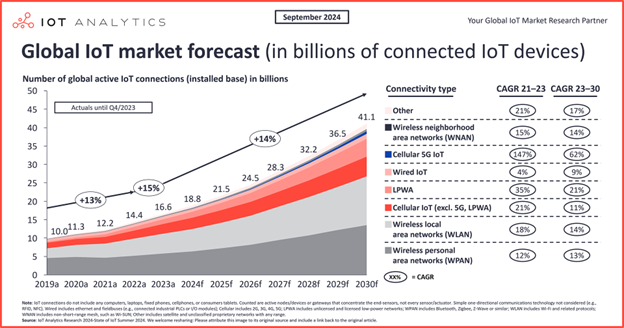The overall impact of the Internet of Things (IoT) on climate change will depend on how the technology is developed, deployed, and used. If implemented responsibly and with a focus on sustainability, IoT has the potential to make a significant positive contribution to combating climate change. However, it is crucial to address the potential negative impacts and ensure that IoT technologies are designed with energy efficiency and environmental sustainability in mind.
By connecting devices and collecting data, IoT technology enables us to optimize resource usage, reduce waste, and monitor environmental conditions. In homes and buildings, IoT devices can automate energy consumption, adjust lighting, heating, and cooling based on occupancy and weather conditions. This leads to significant energy savings and reduced carbon emissions. For farmers, IoT sensors can also monitor soil moisture, temperature, and nutrient levels to optimize irrigation and fertilizer usage. This precision agriculture approach conserves water and reduces chemical runoff, benefiting both the environment and crop yields.
IoT technology also plays a crucial role in waste reduction. Smart waste management systems use sensors to track waste levels in bins, optimizing collection routes, and reducing the frequency of unnecessary pickups. This minimizes fuel consumption and reduces greenhouse gas (GHG) emissions. Additionally, IoT technology can track product movement and inventory levels in supply chains, which helps to prevent overproduction and reduces waste.
In transportation and logistics, IoT optimizes traffic flow, reducing congestion and fuel consumption. Smart logistics systems track shipments in real time, optimizing routes and reducing fuel usage. These advancements contribute to reduced emissions and improved overall efficiency. And finally, IoT technology plays a vital role in sustainable cities. Smart grids enable efficient energy distribution and demand response programs, which reduce energy waste. While IoT technology offers potential benefits, it also comes with potential drawbacks.
Benefits
- Enhanced energy efficiency: Smart grids and buildings equipped with IoT sensors optimize energy consumption by detecting inefficiencies in real time and adjusting usage accordingly.
- Reduced consumption: IoT-enabled supply chain management (SCM) streamlines operations, minimizes waste, and optimizes inventory levels. Smart agriculture optimizes water usage and fertilizer application which reduces the environmental impact.
- Sustainable transportation: IoT-powered smart transportation systems improve traffic flow, reduce congestion, and promote the use of public transportation and electric vehicles.
- Environmental monitoring and conservation: IoT devices monitor air and water quality, detect pollution sources, and track deforestation and other environmental changes.
Drawbacks
- Increased energy consumption: The increasing number of IoT devices and their associated data processing demands can lead to higher energy consumption.
- E-waste generation: The short lifespan of many IoT devices and their eventual disposal can contribute to electronic waste.
- Data privacy and security concerns: IoT devices generate a vast amount of data, which can lead to concerns about data privacy and security. This results in an increased level of energy consumption for data storage and protection.

IoT Applications for Sustainability
- Smart cities: Smart cities leverage IoT technologies in order to optimize resources, reduce waste, and minimize emissions. Through interconnected IoT devices and sensors, smart cities can manage everything from traffic flow to energy consumption more efficiently. One example is how smart lighting systems adjust based on real-time environmental conditions, which significantly reduces energy use. In addition, IoT-enabled public transport can optimize routes and schedules, decreasing the overall carbon footprint of urban transport.
- Ocean conservation: Because the ocean covers over 70% of the Earth’s surface, it is vital for climate regulation, but also faces severe threats from pollution. Each year, 14 million tons of plastic are dumped, which means innovative IoT solutions are crucial in addressing this issue. One initiative is the World Bank-funded drone mapping program, which uses drones to gather images from pollution hotspots. These images create a detailed visualization of marine litter. The images are shared with stakeholders such as fisheries, recyclers, and government officials in order to enhance cleanup efforts and waste management strategies.
- Smart agriculture: Smart agriculture utilizes IoT sensors to monitor soil moisture, crop health, and weather conditions, which allows for precise water and nutrient application. This precision farming boosts crop yields, while also ensuring minimal water and fertilizer use mitigating the environmental impact. In addition, IoT-enabled agriculture can lead to a significant reduction in the carbon footprint by optimizing the supply chain and reducing waste.
- Smart fleet management: Transportation is a significant contributor to global GHG emissions. Smart fleet management that leverages IoT can transform this sector. IoT devices monitor vehicle health, optimize routes, and improve fuel efficiency across fleets. This technology not only reduces operational costs; it also contributes significantly to lowering emissions. Real-time data provided by IoT devices helps companies make informed decisions that align with sustainability goals such as transitioning to electric vehicles (EVs).
Conclusion and Recommendations
While the potential of IoT for sustainability is enormous, several challenges need to be addressed. This includes ensuring the security of sensitive data generated by IoT devices to prevent unauthorized access and cyberattacks. Standardized protocols and communication standards are essential for seamless integration of IoT devices from different manufacturers. In addition, managing and analyzing vast amounts of data becomes a complex task as the number of IoT devices grows. Moreover, the energy consumption of IoT devices must be minimized to maximize the environmental benefits.
By addressing these challenges and leveraging the power of IoT, we have the potential to revolutionize industries, reduce our carbon footprint, and conserve precious resources. As technology continues to advance, we can expect even more innovative applications of IoT that will contribute to a greener planet. Please contact Canopy Edge for a consultation on how your organization could most effectively utilize IoT as part of its abatement strategies and broader sustainability initiatives.


